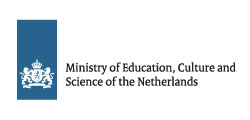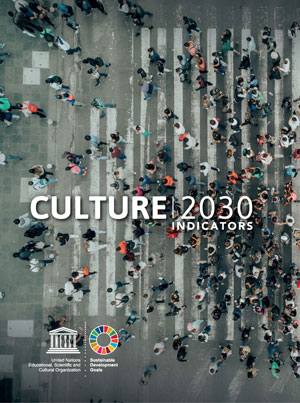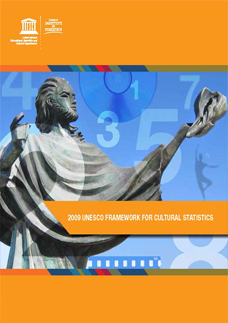Thematic Indicators for
Culture in the 2030 Agenda
The UNESCO Thematic Indicators for Culture in the 2030 Agenda (UNESCO Culture|2030 Indicators) is a framework of thematic indicators whose purpose is to measure and monitor the progress of culture’s enabling contribution to the national and local implementation of the Goals and Targets of the 2030 Agenda for Sustainable Development.
The role of culture in building a more sustainable world is now widely recognized and reflected in the international agenda. UNESCO’s advocacy efforts for the culture and development approach over the last decade resulted in several UN Resolution on Culture and Development adopted by the UN General Assembly, the latest in December 2021 – following 8 similar Resolutions adopted in the previous years, voicing the need to adapt policy frameworks to better anchor culture within sustainable development. A landmark event in this process has been the integration of culture in the 2030 Agenda for Sustainable Development adopted in 2015. Culture is explicitly?
referenced in Target 11.4, ‘Strengthen efforts to protect and safeguard the world’s cultural and natural heritage,’ for which the globally agreed upon indicator 11.4.1 has been elaborated and is reported by UNESCO Institute of Statistics (UIS). Beyond Target 11.4, culture contributes both as a sector of activity and transversally across other sectors. The contribution of culture to sustainable development is also clearly recognized in other milestone international frameworks, including the New Urban Agenda (UN-Habitat).
The framework assesses both the role of culture as a sector of activity, as well as the transversal contribution of culture across different SDGs and policy areas. As a set of thematic indicators, it is intended to support and complement the global indicators agreed upon within the 2030 Agenda and foster linkages between different Goals and Targets. The UNESCO Culture|2030 Indicators framework aims to:
Approach
The lack of reliable data collection, measurement and monitoring processes have represented a significant and critical obstacle in pushing forward the importance of cultural heritage and creativity.
This insufficiency of quantitative evidence, as well as the fragmentation of culture related data, produced by different institutions, have tended to marginalize culture in national and local development strategies and policies as well as within the identified United Nations Sustainable Development Cooperation Framework (UNSDCF) areas for funding.
Bringing the data together and setting up more reliable measurement systems is essential to provide a better understanding of the multiple ways culture contributes to the economic, social and environmental dimensions of sustainable development. This has become all the more urgent in the context for recent calls for Climate Action as well as the global health crisis due to the COVID-19 pandemic.
Implemented of the UNESCO Culture|2030 Indicators is on a voluntary basis by countries and cities, and builds on an in-depth analysis of the multiple ways in which culture contributes to the economic, social and environmental dimensions of development, the UNESCO Culture|2030 Indicators provides evidence of culture’s transformative role, making it more visible and tangible.
Rather than monitoring the contribution of culture to each relevant SDG Target and globally accepted indicator, the UNESCO Culture|2030 Indicators consider the contribution of culture across several of the Goals and Targets, with a view to linking them together. The framework allows aggregation of data across different Goals and Targets around transversal themes in line with UNESCO’s programmes, activities and policies.
By strengthening the transversal visibility of culture in the 2030 Agenda, the UNESCO Culture|2030 Indicators will help build a coherent and strong narrative on culture and development that is evidence-based and would help decision makers.
Data Sources
While relying in priority on national statistical institutes, the UNESCO Culture|2030 Indicators will seek to bring together a variety of data sources, including from different ministries, observatories and public agencies, information systems for culture, specific barometers, specific national and regional surveys, and professional volunteer organization. The project will also support countries to enhance existing data within the UNESCO Culture Conventions and Recommendations periodic reports as well as the cultural data produced by UIS.
The UNESCO Culture|2030 Indicators aims to reap the benefits of UNESCO's unique expertise in collecting and analysing quantitative and qualitative data in the field of culture.
Once the framework is implemented by a city or a country, the analytical material and good practices will help to build a better understanding, with a view to developing a knowledge base with a digital data bank on Culture in the 2030 Agenda. Information collected as part of the implementation of the UNESCO Culture|2030 Indicators in voluntary pilot cities and countries provides a valuable baseline from which to measure progress in addition to directing actions at the local and national levels.
The data also contributes to the formation of a global overview of the state of progress of the contribution of culture to the 2030 Agenda and provides evidence-based and analytical material to support the participation of UNESCO in UN-wide reporting mechanisms related to the 2030 Agenda as well as to the Resolutions of the UN General Assembly pertaining to Culture and Development.
The Data Bank
for the UNESCO 
The UNESCO Culture|2030 Indicators Data Bank has been created to receive the submissions of Member States implementing the framework at the national and urban levels.
Resources
The Publication
The UNESCO Culture|2030 Indicators was launched on the occasion of the Culture of Ministers Forum on 19th November 2019 with more than 120 Ministers of Culture (over 900 participants).The final publication is available online in English, French, Arabic, Spanish, Chinese, Russian?and Thai.
Read the publicationFramework Poster
The UNESCO Culture|2030 Indicators Framework Poster showcases the 22 indicators and the four thematic dimensions, as well as the mapping to SDG targets and UNESCO Culture Conventions. The poster is available in English, French, Arabic, Spanish, Chinese,?Russian?and Thai.
Download the posterImplementation Video
The? video presents the main five steps for the implementation of the UNESCO Culture|2030 Indicators and it is available online in English, French, Arabic, and Spanish.
View the videoTechnical Resources
UNESCO Institute for Statistics (UIS)
The UNESCO Culture|2030 Indicators has been developed in collaboration with the UNESCO Institute for Statistics (UIS).
Visit UISUNESCO Culture for Development Indicators (CDIS)
The UNESCO Culture|2030 Indicators builds on the past achievements of the CDIS.
Learn moreUNESCO Framework for Cultural Statistics (FCS)
The UNESCO Culture|2030 Indicators methodology builds on the FCS.
Read the publicationUNESCO Culture|2030 Indicators Expert Facility
The Expert Facility aims to support countries and cities in implementing the UNESCO Culture|2030 Indicators. It was renewed in 2023 after a four-day orientation workshop held online from October 2023 to January 2024.
The establishment of the UNESCO Culture|2030 Indicators Expert Facility dates back to 2021, following an Online International Expert Workshop held in 2020. Its renewal came as part of the EU-funded project 'Advancing evidence-based policies and actions and supporting policymaking to enhance the contribution of creative sectors and industries to sustainable development,' for a four-year mandate spanning from 2023 to 2026.
UNESCO’s Culture Conventions & Recommendations
The UNESCO Culture|2030 Indicators framework integrates data from reporting on UNESCO Culture Conventions and programmes. Concepts of sustainable development lie at the core of the UNESCO Culture Conventions and programmes, each of them bringing a specific perspective or focus in line with its individual scope and conceptual framework. With the adoption of the 2030 Agenda, all of the Conventions have incorporated relevant SDGs within their implementation and monitoring mechanisms by aligning their concepts and identifying specific SDGs or Targets to be integrated into their results framework.
See also: 2011 Recommendation on the Historic Urban Landscape.
Learn more →
See also: 1980 Recommendation on the Status of the Artist.
Learn more →
First Consultation on the UNESCO Thematic Indicators for Culture in the 2030 Agenda for Sustainable Development by Member States, 2019
The Culture Sector gratefully acknowledges the work of the Member States in carefully preparing their detailed and meticulous responses and the numerous individuals and organizations who have contributed to the consultation. The Member States of UNESCO, their delegations and the relevant ministries, and agencies in each of the responding countries have provided valuable inputs to the survey. The Culture Sector gratefully acknowledges the contribution of the UNESCO Institute of Statistics as well as the Secretariats of the Six Culture Conventions and Recommendations.
The summary of the consultation outcomes is included in an Information Document for the occasion of the 207th session of the Executive Board,
(9 - 23 October 2019).
Related links
Partners
The initiative is supported on a global level by the generous contributions of donors and our partners:
The UNESCO Culture|2030 Indicators has been developed in collaboration with the UNESCO Institute for Statistics (UIS) over a period of two years, with inputs from a number of international experts to measure culture’s contribution to the national and local implementation transversally to the different Goals and Targets of the 2030 Agenda. As a framework of thematic indicators, the UNESCO Culture|2030 Indicators is intended to support and complement the global indicators agreed upon within the 2030 Agenda.

 ? ?
? ? 















































